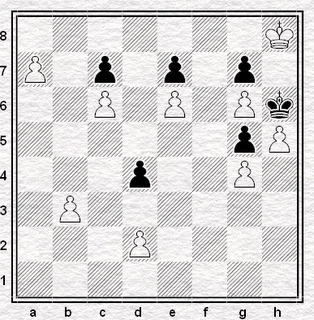
Everyone's talking about it.
No, not EastEnders, not the cricket, and not Streatham & Brixton's new chess blog. I mean of course the Kramnik - Deep Fritz match, game one of which kicks the match off today at 2pm. I recommend the excellent site
Doggers-Schaak's rather interesting preview - it includes predictions from top players, a profile of the computer, details of the unusual rules, some slightly odd photo's, and quotes from Kramnik's press-conference. Let's hope this one in particular proves accurate:
"This computing monster keeps getting better year by year, month by month, day by day: My opponent will be incredibly strong. But I think I can still beat it."
Of course, there'll be live coverage all over the internet and chess servers. I'll be watching it
here - whilst
Chessgames's coverage might (who knows?) offer a more sophisticated level of kibitzing, compared to the usual in-jokes and chatter on the ICC & Playchess. Apart from that, you can find out more about Kramnik from his
home-page, whilst the official site for the match is
here. I'll post the moves of the game up once it's done.
> > > UPDATE > > >
And so - it was a draw.
Kramnik played white, and here are the moves:
1. d4 Nf6 2. c4 e6 3. g3 d5 4. Bg2 dxc4 5. Qa4+ Nbd7 6. Qxc4 a6 7. Qd3 c5 8. dxc5 Bxc5 9. Nf3 O-O 10. O-O Qe7 11. Nc3 b6 12. Ne4 Nxe4 13. Qxe4 Nf6 14. Qh4 (When a computer offers you two rooks for a queen, it's probably a good idea to decline.)
14. ... Bb7 15. Bg5 Rfd8 16. Bxf6 Qxf6 17. Qxf6 gxf6 (Black's activity and slight lead in development will not last for long; therefore, white has the better endgame due to the battered black pawns.)
18. Rfd1 Kf8 19. Ne1 Bxg2 20. Kxg2 f5 21. Rxd8+ Rxd8 22. Nd3 Bd4 23. Rc1 e5 (Moves like 20. ... f5 and 23. ... e5 are typical of a common problems computers have with pawns in endgames: they are often too enthusiastic to move them.)
24. Rc2 Rd5 25. Nb4 Rb5 26. Nxa6 Rxb2 27. Rxb2 Bxb2 28. Nb4 Kg7 29. Nd5 Bd4 30. a4 (Fixing the pawn on b6. But might it have been more exposed on b5 or b4 anyhow? Moves 30 and 31 are critical for determining a winning plan for white - and maybe he got it wrong.
E.g., or the
analysis here.)
30. ... Bc5 31. h3 f6 32. f3 Kg6 33. e4 h5 34. g4 hxg4 35. hxg4 fxe4 36. fxe4 (Maybe white should have penetrated with his king on the queenside before this simplification, or prepared e4 but without g4.)
36. ... Kg5 37. Kf3 Kg6 38. Ke2 Kg5 39. Kd3 Bg1 40. Kc4 Bf2 41. Kb5 Kxg4 42. Nxf6+ (42. Nxb6 Bxb6 43. Kxb6 f5 is trivially drawn.)
42. ... Kf3 43. Kc6 Bh4! (Now the draw is crystal clear.)
44. Nd7 Kxe4 45. Kxb6 Bf2+ 46. Kc6 Be1 47. Nxe5 Game drawn 1/2-1/2
 Or at least, don't prosper at the chess board if you want to live long. That's the message from Sciurus of Squirrel Chess, who blogged here how
Or at least, don't prosper at the chess board if you want to live long. That's the message from Sciurus of Squirrel Chess, who blogged here how











































